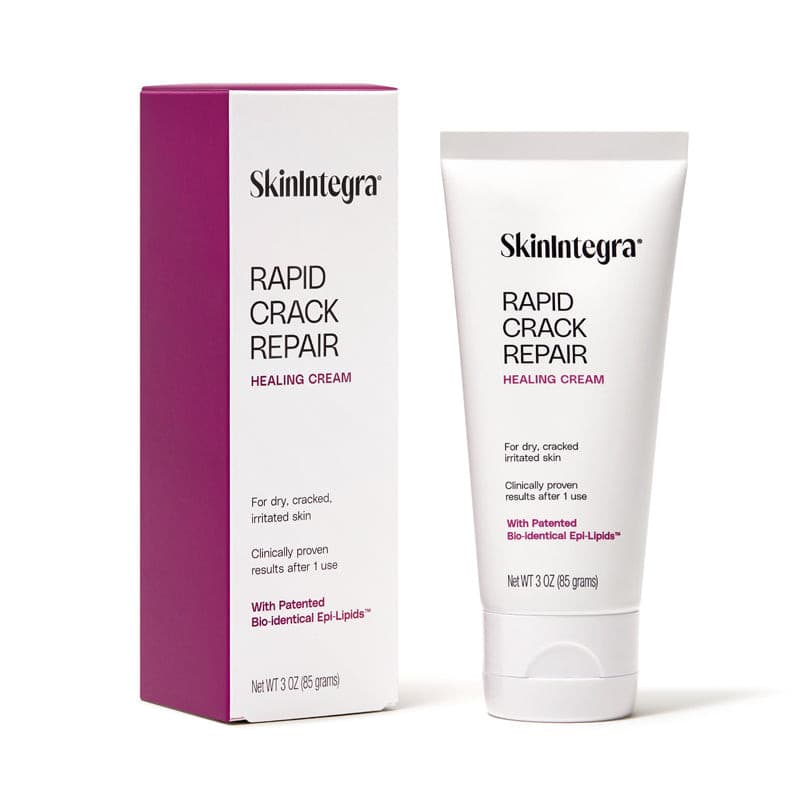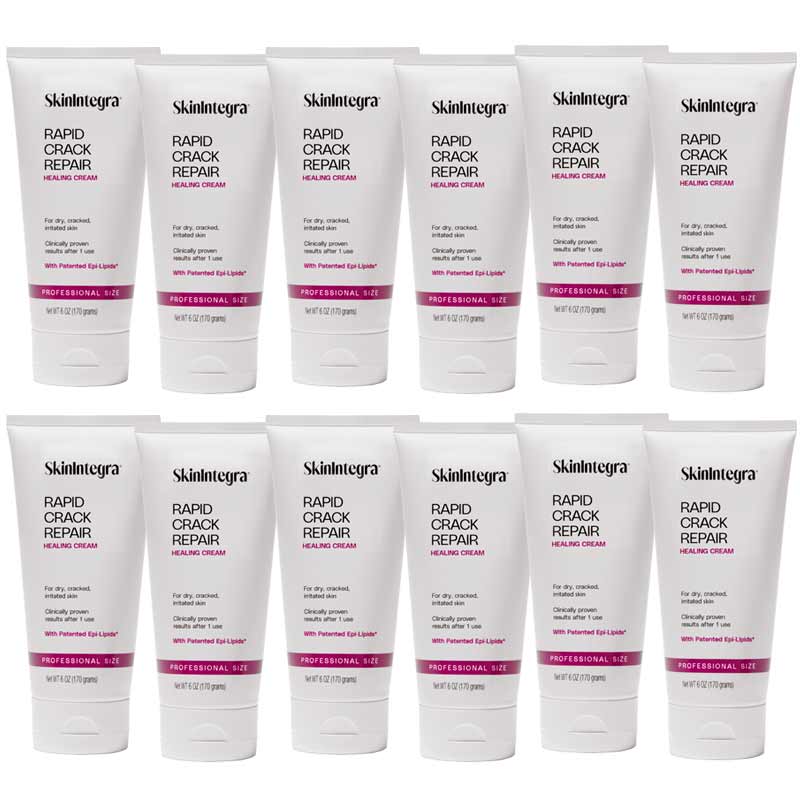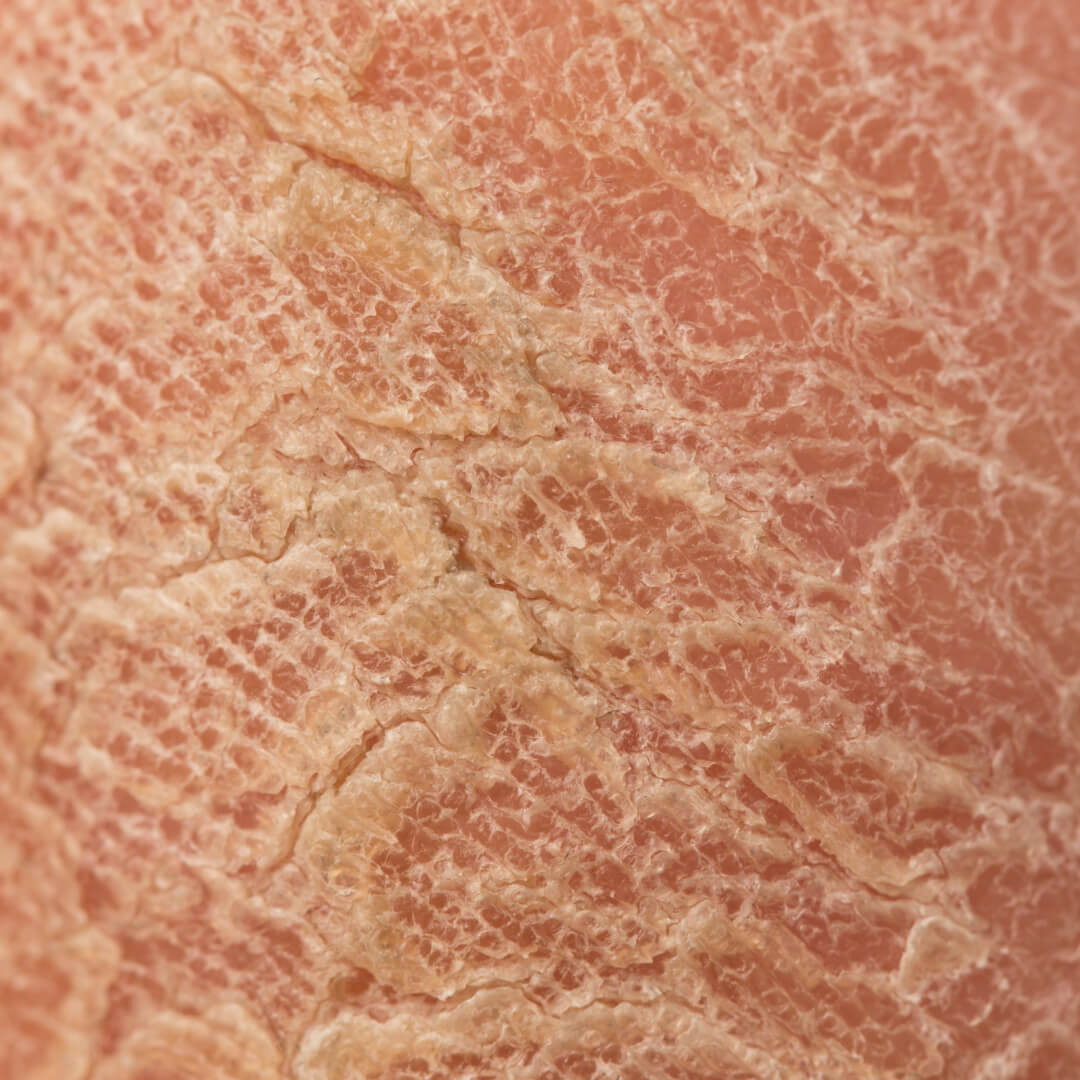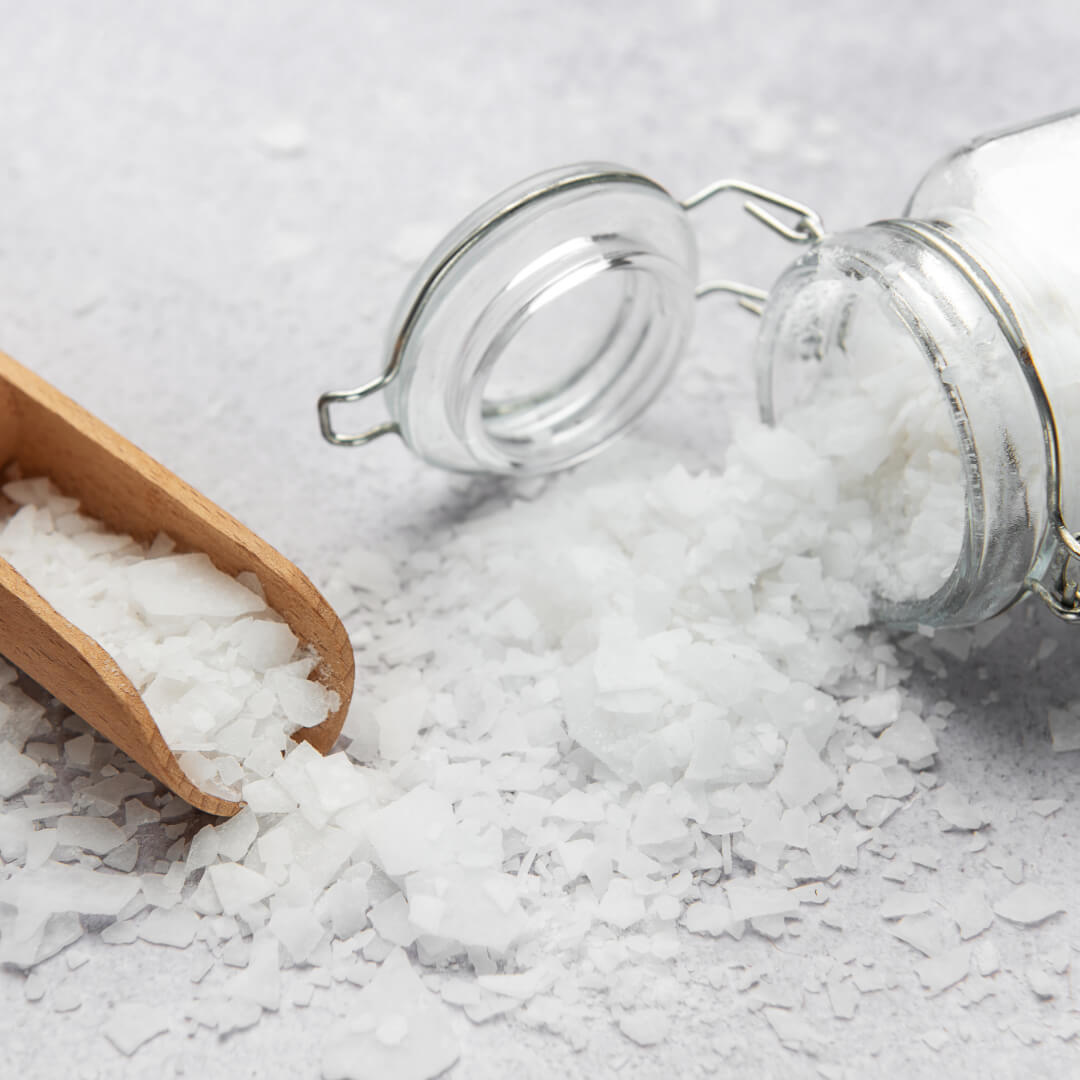Dry, cracked and callused feet are a common struggle for people with diabetes, and nerve damage and poor circulation can turn minor injuries into ulcers or even amputation. Yet social media promotes affordable DIY “foot peel” booties promising baby‑soft skin, tempting people with diabetes to ask whether they are safe.
This article explains why chemical foot peels are risky for diabetic feet, how their ingredients work and why they matter, and offers safer alternatives for managing dry, callused skin. It also introduces SkinIntegra® Rapid Crack Repair Cream, a podiatrist‑approved solution that helps heal cracks and restore the skin barrier.
Why Diabetic Foot Care Demands Extra Caution
If you’ve ever developed a callus or cracked heel, you know it can be painful. For people with diabetes, calluses build up more quickly because of high‑pressure areas on the feet. Neuropathy (nerve damage) often reduces sensation, making it harder to feel friction or minor injuries, and poor circulation slows healing. Untrimmed calluses can become thick, break down and transform into ulcers. The American Podiatric Medical Association (APMA) warns that self‑treating corns or calluses with chemical agents can burn the skin or cause irreparable damage. They recommend letting a healthcare professional trim calluses and seeing a podiatrist regularly.
Recognizing the risks
Neuropathy, poor blood flow and dry, fragile skin create a perfect storm for foot problems. Nerve damage can dull pain and temperature sensations, while narrowed blood vessels slow healing and make infection more likely. Diabetic skin produces less sebum and natural moisturizers, leaving it dehydrated and prone to cracks. Even a tiny cut or blister can rapidly progress to an ulcer or infection if it goes unnoticed. Because of these factors, foot care is more than a cosmetic concern—it is essential to health and independence. So why are foot peels so popular, and what makes them risky?
What Are DIY Foot Peels and How Do They Work?
A foot peel is a type of chemical exfoliation for the feet. Manufacturers sell them as booties lined with a solution containing exfoliating acids. Users wear the booties for 30 to 90 minutes, rinse their feet and wait. After several days, dead skin sheds in sheets, revealing smoother skin underneath. These products became a hit during the COVID‑19 pandemic, when salons were closed and people sought at‑home pedicures.
Key ingredients
The exfoliating power comes from acids:
-
Alpha hydroxy acids (AHAs) such as glycolic acid, lactic acid, citric acid and malic acid. These loosen the bonds (desmosomes) between dead skin cells so they can slough off.
-
Beta hydroxy acids (BHAs), primarily salicylic acid, which dissolves the keratin that makes skin thick.
-
Alcohols and essential oils may be added to soften the skin and enhance absorption.
Because companies rarely disclose the concentration of these acids, shoppers have no way of knowing how strong the peel is. For people without underlying health issues, these products can remove rough patches and calluses. But for people with diabetes, the combination of unknown acid strength, reduced sensation and poor healing can lead to serious complications.
Why DIY Foot Peels Are Risky for Diabetic Feet
1. Unpredictable acid concentrations
Foot peels rely on chemical exfoliants (AHAs and BHAs) to break down skin. However, higher concentrations can cause burns, blisters and increased sensitivity. Since product labels rarely list acid percentages, there’s no way to know how potent the formula is. Over‑the‑counter medicated pads or callus removers containing salicylic acid often carry warnings for diabetics because the acid can damage healthy tissue, and the Mayo Clinic cautions that salicylic acid should be used with care in people with diabetes due to risk of severe redness or ulceration, especially on hands or feet.
2. Insensitive feet mask damage
Reduced sensation means a chemical burn may go unnoticed until the damage is extensive. A person might not feel the product tingling or burning, so they leave it on longer, increasing the risk of deep tissue injury.
3. Slow healing and high infection risk
High blood glucose and poor circulation impair healing, so even small burns or skin tears can become chronic wounds. Experts note that people with diabetes should avoid foot peels because high blood glucose levels affect the body’s ability to heal wounds. When the outer skin layer is compromised, bacteria can enter, leading to infection or ulcers.
4. Drying and irritating ingredients
Many foot peels contain alcohol, artificial fragrances and harsh preservatives that can dry out delicate diabetic skin or provoke inflammation. For people already battling dryness and fissures, this can exacerbate the problem.
5. Lack of regulation and medical oversight
DIY peels are not performed under sterile conditions. Without guidance from a podiatrist or dermatologist, users may not know if they have an open wound, fungal infection or other condition that makes a peel unsafe. If they experience redness, swelling or itching after using a peel, they may delay seeking medical attention.
A Closer Look at Exfoliating Acids
Alpha hydroxy acids (AHAs)
AHAs like glycolic and lactic acid are water‑soluble molecules that loosen the cement between skin cells, causing the top layer to shed. They are used in facial peels at controlled concentrations, typically 10 % or less for at‑home use. In foot peels, concentrations may be much higher to penetrate thick calluses. High amounts of AHAs can trigger inflammation and break down healthy tissue. People with diabetes, whose skin barrier is already compromised, are especially vulnerable to irritation or chemical burns.
Beta hydroxy acid (salicylic acid)
Salicylic acid is oil‑soluble and penetrates deeper into pores, dissolving the keratin that holds thickened skin together. It’s often used to treat acne, warts and calluses. However, salicylic acid can damage both dead and healthy tissue. For people with diabetes, the risks include:
-
Neuropathy masking burns. Nerve damage reduces sensation, so irritation may not be felt.
-
Delayed healing and infection. Small chemical burns can turn into serious ulcers due to impaired circulation and high blood glucose.
-
Systemic absorption. In rare cases, salicylic acid absorbed through the skin can enter the bloodstream, which is more likely with poor circulation.
Because of these dangers, medical professionals strongly advise against using salicylic acid on diabetic skin. The Mayo Clinic explicitly warns not to use salicylic acid plasters for warts, corns or calluses if you are diabetic or have poor blood circulation.
Safer Alternatives: Home Care and Professional Help
Daily at‑home care
-
Inspect your feet daily. Use a mirror or ask someone to help check for cracks, blisters or redness. Neuropathy can mask pain, so don’t rely on sensation alone.
-
Wash and dry gently. Clean feet with lukewarm (not hot) water and mild soap. Avoid soaking; prolonged moisture can dry out skin. Dry thoroughly, especially between toes.
-
Moisturize with diabetic‑safe creams. Look for creams containing gentle humectants like urea (10–25 %) or ammonium lactate, which hydrate and soften calluses. Apply daily, but avoid creams between toes to reduce moisture build‑up.
-
Wear proper footwear. Choose shoes with a wide toe box and cushioning to reduce friction and pressure points. Wear seamless, padded socks to prevent rubbing.
-
Consider orthotics. Custom inserts can redistribute weight and prevent calluses from forming.
When to see a podiatrist
Professional debridement is the safest way to remove calluses for people with diabetes. Podiatrists use sterile instruments to gently shave calluses and address underlying pressure or gait issues. They may recommend therapeutic shoes, orthotics or adjustments to prevent recurrence. Never cut or scrape calluses yourself. Over‑the‑counter callus removers and home pedicures are risky; even small cuts or chemical burns can lead to infection.
Pedicures and foot soaks
Traditional salon pedicures can be unsafe for diabetic feet because shared water tubs and tools may harbor bacteria. Aggressive scraping or cutting can break the skin. If you enjoy salon treatments, seek a podiatrist‑owned medical pedicure facility that follows strict sterilization protocols. Avoid Epsom salt foot soaks; they can dry out skin and increase infection risk for people with diabetes.
Skin‑Friendly Ingredients for Diabetic Feet
Diabetic skin tends to have a weakened barrier and low moisture content. A moisturizer’s job is twofold: hydrate and restore the skin barrier. When shopping for foot creams or balms, look for general categories of ingredients rather than trendy actives.
-
Humectants like moderate-concentration urea (10–25 %) or ammonium lactate attract water to the skin and soften hard calluses without burning.
-
Emollients and lipid‑rich oils (e.g., shea butter, glycerin, plant oils) smooth and fill cracks, helping to prevent fissures.
-
Ceramides and essential fatty acids replenish the skin’s natural lipid content, restoring barrier function.
Avoid lotions with fragrances, alcohol, retinoids or high‑concentration acids, all of which can trigger inflammation. Remember, gentle and hydrating products are key.
SkinIntegra® Rapid Crack Repair Cream: A Podiatrist‑Approved Solution
For those looking for a fast-acting product that is safe for diabetic feet, SkinIntegra® Rapid Crack Repair Cream offers an evidence‑based alternative. Developed by a former Johnson & Johnson scientist and endorsed by podiatrists, this patented formula is designed specifically for dry, cracked and callused skin common in diabetes.
Why it works
-
Combines 25 % urea & lactic acid with barrier‑repair ingredients—hyaluronic acid, ceramides and natural oils—to gently soften callus buildup and restore moisture and strength to the skin.
-
Clinically proven to heal cracks quickly: in trials, patients saw visible improvement within one day and significant relief by two weeks. The formula is free of fragrances, dyes and parabens and has earned the American Podiatric Medical Association’s Seal of Approval.
How to use it
-
Apply daily after washing and drying your feet; use post‑debridement or during flare‑ups to maintain smooth, healthy skin and extend the time between podiatry visits.
By combining gentle exfoliation with deep hydration and barrier repair, SkinIntegra provides an effective alternative to risky DIY foot peels and helps break the cycle of dry, cracked skin.
Frequently Asked Questions
Can I use a foot peel if my diabetes is well managed?
Even when blood sugar is controlled, neuropathy and circulation problems may still exist. Avoid chemical peels and consult a podiatrist before trying any callus remover.
What should I do if I already used a foot peel and my feet are irritated?
Stop using the product immediately. Rinse your feet thoroughly and watch for redness, blisters or swelling. Contact your doctor right away if you notice irritation or signs of infection.
How can I soften calluses safely at home?
Moisturize daily with a urea‑based cream, wear well‑fitted shoes and never cut calluses yourself. Regular visits to a podiatrist for trimming are the safest way to manage thick skin.
Conclusion: Healthy Feet Without Risky Peels
The promise of “baby‑soft” feet from a $6 set of booties is alluring, especially when calluses and cracks are constant companions. But for people with diabetes, the risks far outweigh the benefits. Chemical foot peels contain strong acids whose concentrations are often undisclosed and can cause burns, blisters and ulcers. Neuropathy and poor circulation mean injuries may go unnoticed and heal slowly, leading to infections and other complications. Experts across podiatry and dermatology agree: people with diabetes should avoid foot peels altogether.
The good news is that safer alternatives exist. Daily foot inspections, gentle washing and thorough drying, diabetic‑safe moisturizers and proper footwear can help prevent cracks and callus build‑up. Regular visits to a podiatrist ensure any problems are addressed early. Products like SkinIntegra® Rapid Crack Repair Cream provide a medically backed, gentle approach to exfoliation and barrier repair, offering relief without the dangers of DIY chemical peels.
Your feet carry you through life. With informed choices and the right care, they can remain healthy and pain‑free—no harsh peels required.





